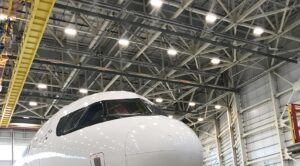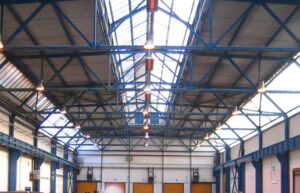For best performance, annual maintenance should be performed prior to the heating season on Superior Radiant Product heaters. Recommendations for our outdoor heaters or specific heater models can be found in the product Installation/Operation Manual. (Please visit our Resource Page)
Series VS/VS-VH Vacuum Systems
General Safety Reminders:
- Ensure Gas Supply and Electrical Power are shut OFF before commencing maintenance work. Exception:
Checking ignitor flames will require the system to be operational. - Keep the area clear and free from combustible materials, gasoline, and other flammable vapors and liquids.
- Caution: Label all wires prior to disconnection when servicing controls. Wiring Errors can cause improper and dangerous operation.
- Verify proper operation and set-up (as listed in the Commissioning section) after servicing.
The System
- Inspect the Common Tailpipe and Vent Pipe for soot or dirt, and clean as required to avoid obstructions.
- Check that Flexible Boot Connectors are without cracks, kinks, or leaking connections. Change the Connectors
every three to four years. - Ensure that the Vacuum Pump and motor mounting bolts are tight.
- Make a visual inspection (without dismounting) of the Vacuum Pump impeller.
- Inspect the Vacuum Switch connections.
- Clean the Condensate Trap and ensure that all piping to/from the Condensate Trap allows free flow of fluid.
- Make spot checks of the interior of the Radiant Line Tubes for soot or obstructions, and clean as required.
- Re-align reflectors and supports as the case may be.
Each Burner
- Remove the Burner and inspect the burner face for soot or cracks. Burner feet should be back flushed with air every year, to clean the internal ceramic burner.
- Visually inspect the electrode. Replace if there is excessive oxidation, erosion, or cracks in the ceramic insulators. Set the spark gap at 0.125” (3.2 mm) and clean the electrodes.
- Verify that flame observation glass is clean, free of cracks, and airtight.
- Inspect the air filter. Change as necessary – frequency is dependent on the environment.
Note: Dirty air filters will restrict combustion air flow into the burner housing, creating a slight negative pressure environment for the zero governor (and other controls). Consequently, while flame characteristics and balance will not change appreciably, the overall burner rate will decline.
Very dirty filters will cause the flame to become more rich (Yellow and soft).
Filters can be cleaned once with reverse air pressure, but it is generally more cost-effective to merely replace them.
- For VS Air Filter includes a frame (Bulk Qty. 20) use part No. VH001B
- For VS Filter Media Kits (Bulk Qty 24) use part No. VH053B
Adjust the System
- Turn on gas and electric power.
- Start the system and allow it to run for 30 minutes.
- Verify end plate vacuum settings against the Installation/Operation Manual, to establish correct burner rates with a manometer. Check the vacuum at the End Vent Cap of the longest Branch. (Refer to Figure 47 for manometer positioning details.)
- If the Vacuum is too low, inspect the Flexible Boot Connectors on the Inlet and Outlet of the Vacuum Pump for tight connections, leaks, damage, kinks, etc.
- To adjust the vacuum on a single leg, manipulate the damper coupling at the end of that leg.
- To adjust the vacuum on the entire system, manipulate the damper coupling at the vacuum pump.
- There should be no sound of leaking air around any of the various gaskets or connections.
Adjust the System Burners
- Observe each flame through the flame sight glass.
- Flame may flutter once or twice at ignition but should settle promptly.
- Flame should extend straight out from Ignitor.
- Sense rod (and ignitor) will glow bright red/orange on all except No.1 Burners.
- End burners (No. 1, or the furthest upstream from the vacuum pump) do not need to be adjusted. The flame in No. 1 burner appears soft and fluffy, it is solid blue in color.
- All downstream burners (Nos. 2 – 4) may require adjustment of the Maxitrol regulator located inside each VS burner; refer to Burner Adjustment under Commissioning Chapter.
- VS systems with multiple in-series burners can occasionally produce a high-pitched noise that can best be described as a whistle or howl. Usually, the howl is produced by a rich No. 2 burner. De-tune the burner by slowly reducing the gas pressure at the internal Maxitrol regulator in the burner. You may also have to de-tune the No. 3 burner. Turn down the pressure till the noise disappears. Reducing it too much may cause ignition problems later.
Infrared Tube Heaters Series U/L/T/LT/AM
For best performance, certain minimal maintenance procedures should be performed before each heating season:
- A service agency qualified to adjust, and repair infrared heaters should be engaged for service other than routine maintenance.
- Before performing any service or maintenance, shut off the gas and electrical supply to the heater.
- Check the condition of the forced air blower scroll and motor. Dirt and dust may be blown or vacuumed from the blower wheel as needed.
- Check the condition of the burner. Remove any foreign objects or debris from inside the burner box or burner cup.
- Inspect the igniter. Replace the igniter if there is excessive wear or erosion, breakage, or other defects.
- Be sure the burner observation window is clean and free of cracks or holes. Clean or replace as necessary.
- Inspect housing gaskets; repair or replace as needed.
- Check the flue pipe for soot or dirt and reattach to the heater after cleaning as necessary.
- The reflector sections may be cleaned by wiping with a damp cloth. Internal surfaces should be free of dirt or oxidation.
- Be sure the vent terminal and fresh air inlet are free from obstructions. If either pipe is restricted, the safety air switch will not operate properly, and the heater could fail to operate.
- Check the inside of the heat exchanger tube visually with a flashlight. If carbon or scale is present, scrape or otherwise remove deposits (a wire brush works well).
Series S/M/KMI High-Intensity Heaters
For best performance, certain minimal maintenance procedures should be performed before each heating season.
- Close the fuel gas valve and de‐energize electrical power to the heater.
- With an air hose regulated to no more than 15 psig blow away accumulated dust. Blow across the face of the ceramic tiles, not directly at them. Blow into each venturi for about one minute.
- Verify that there are no cracked tiles.
- Review the wiring for any loose connections.
Technical Support
1 800 527-HEAT (4328) Ext.90
techsupport@superiorradiant.com






